10
Safe Exercise Tips for Asthma & COPD
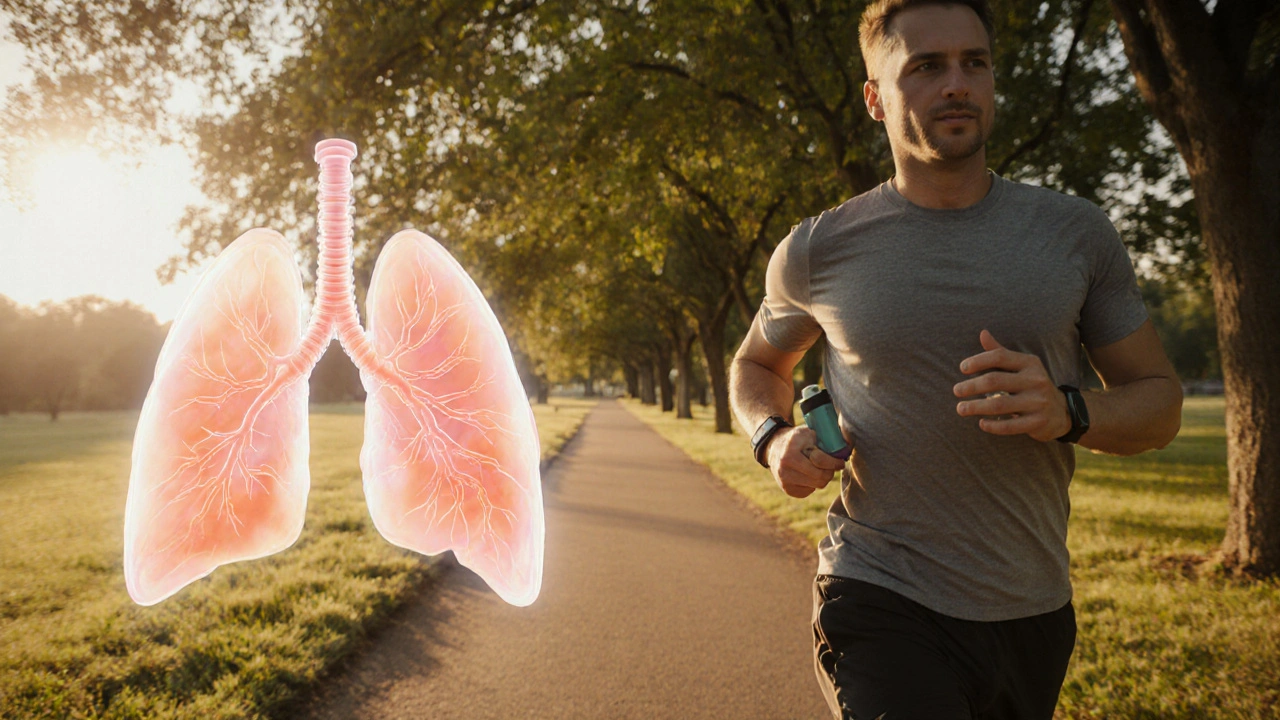
Safe Exercise Planner for Asthma & COPD
Personalized Exercise Plan
This tool helps you create a safe weekly exercise routine based on your condition and current fitness level.
Your Personalized Exercise Plan
When you live with breathing disorders is a group of conditions that limit airflow in and out of the lungs, such as asthma and chronic obstructive pulmonary disease (COPD), staying active can feel risky. The good news is that regular movement actually strengthens the lungs, improves oxygen delivery, and helps control symptoms - you just need the right plan.
Why Exercise Matters for the Lungs
Physical activity does three things that matter for anyone with a breathing disorder:
- Boosts cardiovascular efficiency, so the heart delivers oxygen more easily.
- Improves the muscles that help you breathe, making each breath less effortful.
- Reduces inflammation and mucus buildup, lowering the chance of flare‑ups.
But the same effort that benefits your lungs can also trigger shortness of breath if you jump in too fast. Knowing your limits and preparing properly is the key.
Common Breathing Disorders That Affect Exercise
Asthma is a chronic condition characterized by airway hyper‑responsiveness, leading to wheeze, cough, and tightness during exertion. It affects around 339million people worldwide and is a leading cause of exercise‑induced symptoms.
Chronic Obstructive Pulmonary Disease (COPD) combines emphysema and chronic bronchitis, reducing airflow and causing persistent breathlessness, especially during sustained activity. In the UK, roughly 1.2million adults have a COPD diagnosis.
Both conditions can produce exercise‑induced bronchoconstriction (EIB), a temporary narrowing of the airways that typically peaks 5-15 minutes after starting exercise.
Pre‑Exercise Checklist: Gear Up for Success
- Check your medication. A short‑acting bronchodilator (e.g., albuterol) taken 10‑15 minutes before activity can prevent EIB.
- Measure baseline lung function with a peak flow meter, which gives a quick reading of how fast you can exhale. Aim for at least 80% of your personal best before starting.
- Warm‑up gently for 5‑10 minutes. Low‑intensity walking or static stretching raises body temperature without overtaxing the airways.
- Stay hydrated. Dehydration thickens mucus, making it harder to clear.
- Choose appropriate clothing - breathable fabrics reduce overheating, which can aggravate symptoms.
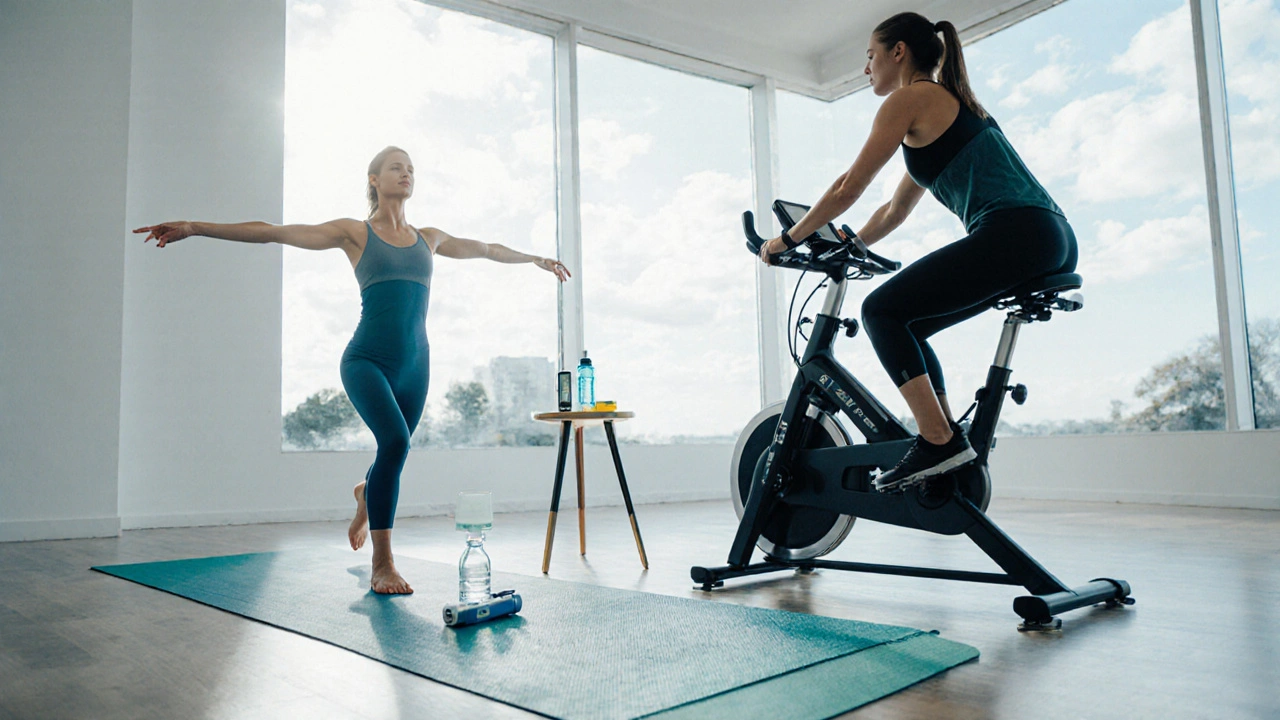
Choosing Safe Activities
Not every workout feels the same to a person with a breathing disorder. Here are some options that balance cardiovascular gain with airway control:
- Walking: Low impact, easy to pause, and can be done indoors on a treadmill where temperature is stable.
- Cycling (stationary or outdoor): Allows a steady rhythm and can be paced with gears.
- Interval training: Short bursts of higher intensity followed by longer recovery periods. Works well for asthma because the recovery time lets airways re‑open.
- Yoga and Pilates: Focus on breathing control, flexibility, and core strength without high heart‑rate spikes.
- Swimming (if humidity is controlled): Warm, moist air reduces airway irritation, but be sure the pool chemicals aren’t triggering.
All of these can be adapted to a pulmonary rehabilitation program, which tailors intensity, monitors progress, and provides professional guidance.
Sample Weekly Plan (Beginner Friendly)
| Day | Activity | Duration | Intensity (RPE 1‑10) |
|---|---|---|---|
| Monday | Brisk walking | 30min | 3‑4 |
| Tuesday | Yoga (focus on breath work) | 45min | 2‑3 |
| Wednesday | Rest or gentle stretching | - | - |
| Thursday | Stationary cycling - interval | 20min (2min on / 3min off) | 4‑5 on, 2 off |
| Friday | Light strength training (upper body) | 30min | 3‑4 |
| Saturday | Walk‑jog intervals (walk 2min, jog 30sec) | 25min | 4‑5 during jog |
| Sunday | Rest or leisure activity (gardening, light housework) | - | - |
Adjust the times and intensity based on how you feel. The key is consistency, not speed.
During the Workout: Monitoring & Breathing Techniques
Keep an eye on three simple signals:
- Heart rate: Aim for 50‑70% of max (220‑age) for moderate activity. A smartwatch or chest strap makes this easy.
- Oxygen saturation (SpO₂): If you own a pulse oximeter, stay above 92% during effort.
- Breathlessness scale (the Borg rating of perceived exertion). If you rate a 7 or higher, it’s time to slow down.
Practice these breathing tricks to stay calm:
- Pursed‑lip breathing: Inhale through the nose, then exhale slowly through pursed lips. This keeps airways open longer.
- Diaphragmatic breathing: Place one hand on your chest, the other on your belly. Breathe so the belly rises more than the chest.
- Box breathing (4‑4‑4‑4): Inhale 4seconds, hold 4, exhale 4, hold 4. Use it during rest intervals.
If you notice wheezing, sudden chest tightness, or a drop in SpO₂, pause, use your reliever inhaler, and walk slowly until symptoms ease.
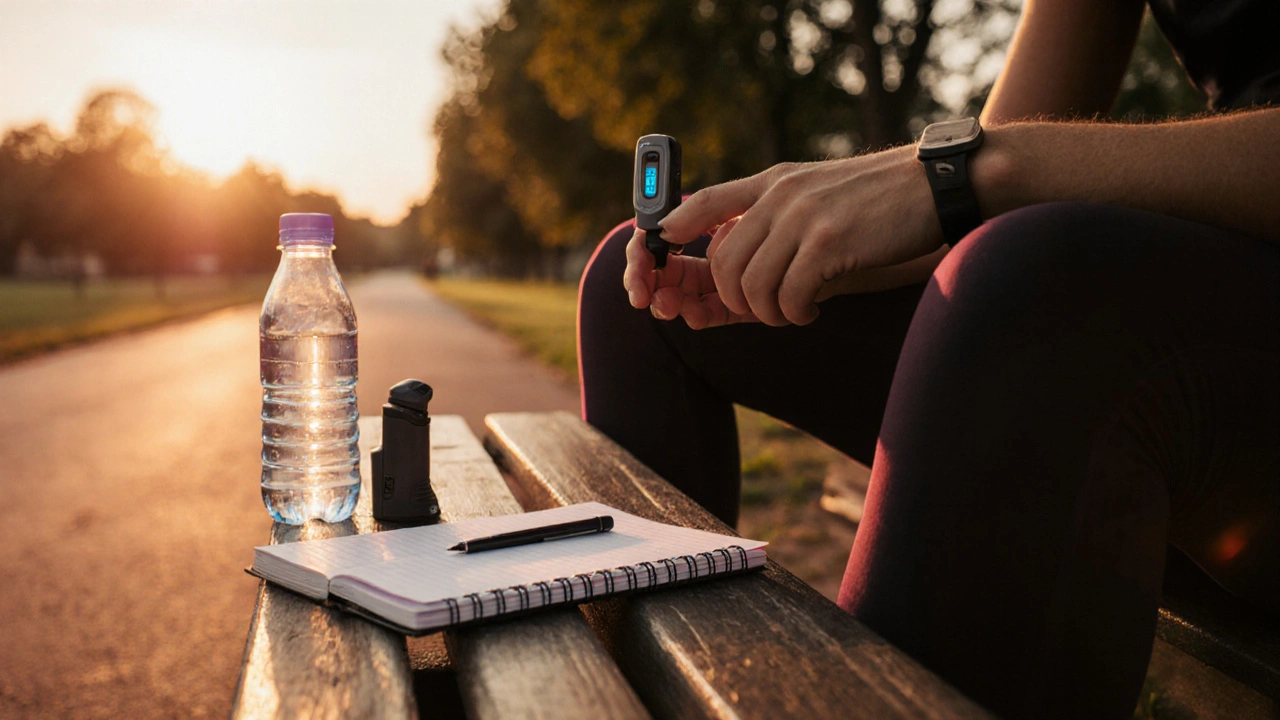
Post‑Exercise Recovery
Recovery is where the lungs rebuild:
- Cool down for 5‑10minutes with gentle walking or stretching.
- Repeat the peak flow measurement. A post‑exercise reading within 5% of pre‑exercise means you managed well.
- Hydrate and consider a short‑acting bronchodilator if you feel residual tightness.
- Log the session (duration, intensity, symptoms). Over time this data helps you spot patterns and adjust medication.
When to Seek Professional Help
If any of these happen repeatedly, contact a healthcare provider:
- Frequent need for rescue inhaler during or after exercise.
- Peak flow consistently below 70% of personal best.
- Chest pain, dizziness, or uncontrolled coughing.
They may adjust your inhaler dosage, suggest a different medication class, or refer you to a specialist pulmonary rehabilitation program.
Key Takeaways
- Exercise strengthens lungs but must be introduced gradually.
- Use a bronchodilator before activity and monitor peak flow.
- Low‑impact activities like walking, cycling, yoga, and interval training are safest for breathing disorders.
- Track heart rate, oxygen saturation, and perceived breathlessness during workouts.
- Cool down, re‑measure peak flow, and log each session for long‑term improvement.
With the right plan, staying active becomes a powerful tool rather than a trigger. Remember, the goal isn’t to push yourself to the limit every day - it’s to keep moving just enough to let your lungs get stronger while you feel comfortable.
Frequently Asked Questions
Can I run if I have asthma?
Yes, but start with short intervals (run 30seconds, walk 2minutes) and use a reliever inhaler 10minutes before you begin. Gradually increase the run time as your lungs adapt.
Should I avoid the gym because of air quality?
Indoor gyms with good ventilation are usually fine. If you notice strong smells or dust, choose a well‑ventilated area or move your routine outdoors on a low‑pollution day.
How often should I measure my peak flow?
At least twice a week, and additionally before and after any new exercise session. Consistent tracking helps you see trends and catch early warning signs.
Is swimming safe for COPD?
Swimming can be gentle on the airways because the water’s humidity keeps them moist. Just avoid heavily chlorinated pools if the chemicals irritate you, and use your inhaler as needed.
What if I forget my inhaler before a walk?
Walk at a slower pace, focus on pursed‑lip and diaphragmatic breathing, and stop as soon as you feel any tightness. Plan to keep a spare inhaler in a bag or pocket for the future.
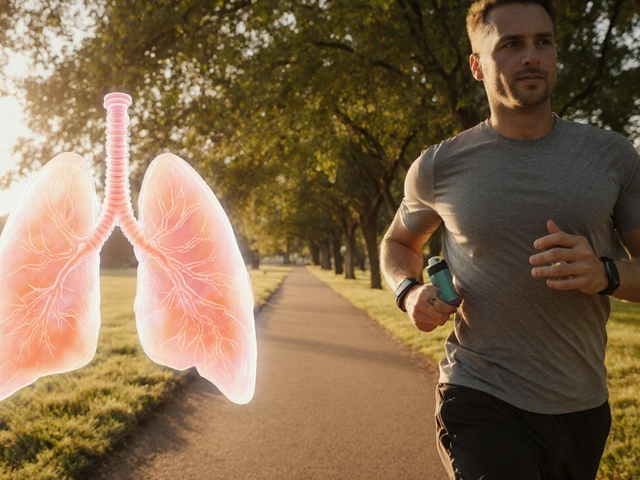
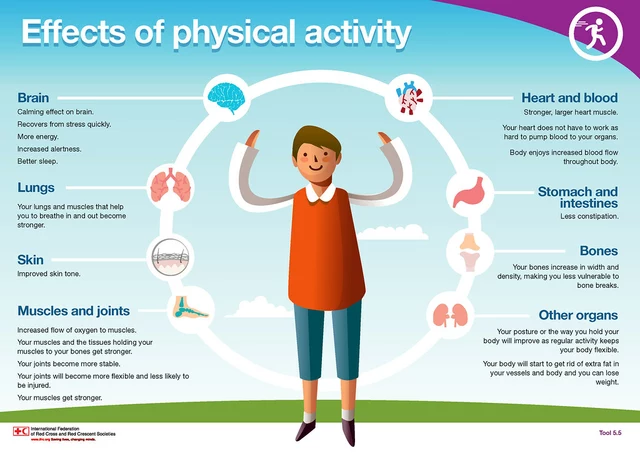







Anastasia Petryankina
October 10, 2025 AT 16:10Oh look, another generic exercise chart for people who think breathing is just a minor inconvenience. As if a walking plan solves the deep existential dread of a wheeze.
Tim Ferguson
October 14, 2025 AT 02:16Honestly, the whole "monitor your peak flow before you jog" thing feels like a modern myth. You can just live in the moment and accept that the lungs will adapt eventually, right?
Noah Cokelaere
October 17, 2025 AT 12:22Seriously, the plan’s cool but you gotta remember your breath is like a fickle friend-sometimes it shows up, sometimes it ghosts you. So just keep moving, maybe the lungs will RSVP.
Ashley Helton
October 20, 2025 AT 22:29Nice breakdown, but let’s be real: most of us will just binge‑watch Netflix after the “light stretching” day and call that a rest day. No shame.
Brian Jones
October 24, 2025 AT 08:35Okay, look-if you actually want a plan that sticks, start with five minutes of gentle movement, then *actually* use your inhaler, and repeat. Consistency beats perfection.
Carlise Pretorius
October 27, 2025 AT 18:41yeah thats good but dont forget to stay hydrated its key, and the whole thing isnt rocket science just keep breathing and keep moving
Johnson Elijah
October 31, 2025 AT 04:48Yo folks, loving the focus on low‑impact stuff-walking, cycling, yoga-those are the real MVPs for us lung‑warriors! 🌟 Keep the vibes positive and the lungs happy.
Roxanne Lemire
November 3, 2025 AT 14:54i think the breathing techniques mentioned are spot on, but remember to tailor the intensity to how your chest feels that day
Alex Mitchell
November 7, 2025 AT 01:00👍 Totally agree-listen to your body, log each session, and adjust the meds if you notice a pattern. Small steps, big gains.
Narayan Iyer
November 10, 2025 AT 11:07From a rehab perspective, integrating interval training with proper warm‑ups can actually recalibrate airway responsiveness-think of it as a tactical re‑programming of the bronchi.
Amanda Jennings
November 13, 2025 AT 21:13Love the energy! Just remember to keep the intervals short enough so you don't over‑trigger the EIB. 30‑second bursts are perfect for most.
alex cristobal roque
November 17, 2025 AT 07:19Alright, let’s break it down. First, you want a baseline measurement-your peak flow should be at least 80% of personal best. Second, always have your short‑acting bronchodilator handy; a puff 10‑15 minutes before you start can make the difference between a smooth jog and a coughing fit. Third, warm‑up is non‑negotiable: five to ten minutes of low‑intensity movement gets the airways ready and reduces the risk of bronchoconstriction. Fourth, choose activities that are low‑impact but still challenge the cardiovascular system-think brisk walking, stationary cycling, and yoga. Fifth, remember breathing techniques: pursed‑lip breathing helps keep airways open during exertion, while diaphragmatic breathing maximizes oxygen intake. Sixth, monitor vital signs; a smartwatch can keep an eye on heart rate, aiming for 50‑70% of max, and a pulse oximeter should stay above 92% SpO₂. Seventh, stay hydrated; water thins mucus and eases clearance. Eighth, keep a simple log-date, activity, duration, intensity, and any symptoms. Ninth, after the workout, cool down for five to ten minutes with gentle walking or stretching; this helps normalize breathing patterns. Tenth, repeat the peak flow after exercise; if it’s within five percent of the pre‑exercise value, you’re in the safe zone. Eleventh, if you notice any wheezing or sudden tightness, pause, use your inhaler, and walk slowly until it eases. Twelfth, schedule regular check‑ins with your pulmonologist to adjust medication if needed. Thirteenth, consider joining a pulmonary rehab program for professional guidance and social support. Fourteenth, vary your routine every few weeks to keep the body adapting and avoid plateaus. Finally, be patient with yourself-progress is gradual, and consistency beats intensity every time.
Bridget Dunning
November 20, 2025 AT 17:26Esteemed colleagues, it is imperative that we acknowledge the salutary effects of controlled aerobic activity upon pulmonary function, particularly within the framework of evidence‑based pulmonary rehabilitation protocols.
Shweta Dandekar
November 24, 2025 AT 03:32While the above is commendable, it must be emphasized-exercising without proper inhaler timing is a grave oversight; one must always adhere to the recommended prophylactic dosing!